Melophorus turneri
| Melophorus turneri | |
|---|---|

| |
| Scientific classification | |
| Kingdom: | Animalia |
| Phylum: | Arthropoda |
| Class: | Insecta |
| Order: | Hymenoptera |
| Family: | Formicidae |
| Subfamily: | Formicinae |
| Tribe: | Melophorini |
| Genus: | Melophorus |
| Species group: | biroi |
| Species complex: | fieldi |
| Species: | M. turneri |
| Binomial name | |
| Melophorus turneri Forel, 1910 | |
| Synonyms | |
| |
In many ways, this is the archetypal Melophorus and the one most likely to be seen by members of the public in temperate Australia. Melophorus turneri is commonly seen in country areas, where it is ubiquitous in almost all habitats away from the wettest areas. Even paddocks that carry only a very depauperate ant fauna will usually support colonies of this species. (Heterick 2009, Heterick et al. 2017)
Identification
Heterick et al. (2017) - Melophorus turneri can be placed in the Melophoprus biroi species-group on the basis of characters of the clypeus, propodeum, mandible and palps. The species is also placed in the Melophoprus fieldi species-complex because of the appearance of the anteriorly placed clypeal psammophore, the compact propodeum, the presence of more than one preapical spine on the metatibia, at least in the major worker, long, even spindly legs and an unmodified mandible in the major worker. Melophorus turneri has a very variable morphology, the populations overall resemble those of up to a dozen other species, and this taxon is almost impossible to define in a simple species diagnosis. However, in all populations the appressed setae on the gaster of all subcastes are very small and inconspicuous when the gaster is moderately distended, such setae being separated from one another by at least their own length (unlike Melophorus inconspicuus, Melophorus hirsutipes, etc.). For differences between M. turneri and Melophorus eumorphus and Melophorus vitreus, which share this type of pilosity, see the identification section under those species. These appressed setae are also inconspicuous on the mesosoma and never long and silvery (as in Melophorus lanuginosus). The node of the minor worker is often squamiform, and most commonly the cuticle is shining or even glossy with vestigial or weak shagreenation. Melophorus longipes is very similar to ‘typical’ M. turneri but the metafemur of the minor worker of M. turneri is shorter and stouter (0.75 × length of mesosoma ≤). In profile, the minor worker propodeum generally has a weak to strong angle between the dorsal and declivitous surfaces, also differentiating this ant from M. longipes. The major worker is more difficult to distinguish from that of M. longipes, but the turneri mesonotum is generally moderately convex in profile and the metafemur uniformly pale brown ochre to yellowish, the tibia being of the same colour as the femur. Melophorus perthensis can also be confused with M. turneri: see the identification section under that species for the distinguishing characters between the two ants.
The “pillipes” condition (whorls of fine, erect setae on appendages) occurs within this species (Melophorus pillipes being reduced to a junior synonym of M. turneri in this work). Melophorus turneri with the “pillipes” condition can be distinguished from Melophorus ankylochaetes, Melophorus incisus and Melophorus hirsutipes by having true appressed setae on the gaster, and from two other ants with the “pillipes” condition (Melophorus vitreus and Melophorus lanuginosus) by the characters mentioned under the identification section for those two species. Finally, M. turneri (“pillipes”) has a smooth mesopleuron, whereas those individuals of M. hirsutipes (“pillipes”) which have appressed setae on the gaster have a sculptured mesopleuron.
The unexceptional appearance of the ant can lead it be confused with several other members of the fieldi complex, from which it can be distinguished by the combination of the appearance of the appressed setae on the first gastral tergite (separated by more than their length), the moderate eye size in most populations, its relatively short, thick metatibia and the usually glabrous or relatively glabrous mesosoma. Populations that display the ‘pillipes’ condition – the taxon pillipes is in fact here relegated to junior synonym status under turneri – are among the most spectacular manifestations of the variation seen in turneri; workers being hairy and shiny, with a brush of fine, straight, erect setae that branch from their tibiae in whorls at a right angle or near, and with a strongly truncate propodeum.
Heterick (2009) - A very variable species in terms of pilosity and appearance of the cuticle: commonly the more hirsute workers have a matt, shagreenate cuticle while those that are more-or-less glabrous are smooth and shiny. However, this is not invariably the case. Colour of the cuticle ranges from pale yellowish-brown or red to almost black. Most workers, whatever their colour, tend to have a coppery iridescence. Dark brown to black populations close to the coast have smaller eyes, especially among the minor and media workers.
Keys including this Species
Distribution
Heterick et al. (2017) - The ant has a more widespread distribution throughout mainland Australia than any other member of the genus, and can be found from the tip of Cape York, in QLD, to the southernmost parts of Victoria. There are, however, no Tasmanian records.
Latitudinal Distribution Pattern
Latitudinal Range: 22.5045° to -29.88333333°.
| North Temperate |
North Subtropical |
Tropical | South Subtropical |
South Temperate |
- Source: AntMaps
Distribution based on Regional Taxon Lists
Australasian Region: Australia (type locality).
Distribution based on AntMaps
Distribution based on AntWeb specimens
Check data from AntWeb
Countries Occupied
| Number of countries occupied by this species based on AntWiki Regional Taxon Lists. In general, fewer countries occupied indicates a narrower range, while more countries indicates a more widespread species. |

|
Estimated Abundance
| Relative abundance based on number of AntMaps records per species (this species within the purple bar). Fewer records (to the left) indicates a less abundant/encountered species while more records (to the right) indicates more abundant/encountered species. |

|
Biology
Heterick et al. (2017) - This very common ant has been taken from a great variety of habitats but mallee scrub and sandy soils predominate in the label data. However, M. turneri has even been taken amid mangroves (Port Adelaide, South Australia)! In Western Australia the species is one of a small number of native ants regularly collected in paddocks. The ant is therefore likely to be an adaptable generalist.
Castes
Worker
  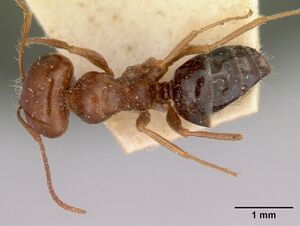 
| |
| . | Owned by Australian National Insect Collection. |
 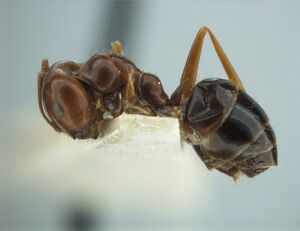  
| |
| . | Owned by Museum of Comparative Zoology. |
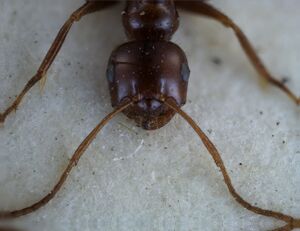 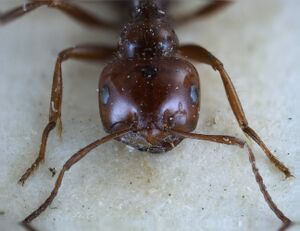     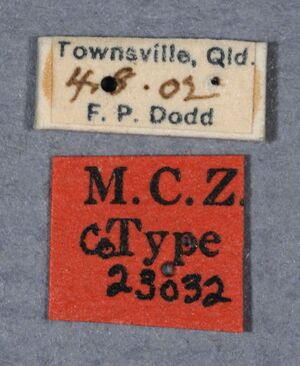
| |
| . | Owned by Museum of Comparative Zoology. |
[[File:|300px]]    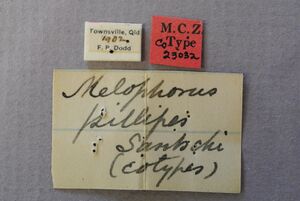
| |
| . | Owned by Museum of Comparative Zoology. |
   
| |
| . | Owned by Museum of Comparative Zoology. |
Phylogeny
| Melophorus |
| ||||||||||||||||||||||||||||||||||||
Based on Heterick et al., 2017. Only selected species groups/complexes are included.
Nomenclature
The following information is derived from Barry Bolton's Online Catalogue of the Ants of the World.
- turneri. Melophorus turneri Forel, 1910b: 63 (s.w.) AUSTRALIA.
- Viehmeyer, 1914b: 43 (q.); Wheeler, G.C. & Wheeler, J. 1968: 206 (l.).
- Combination in M. (Erimelophorus): Wheeler, W.M. 1935c: 71.
- Status as species: Viehmeyer, 1914b: 43; Emery, 1925b: 12; Clark, 1938: 375; Taylor & Brown, 1985: 124; Bolton, 1995b: 250; Heterick, 2009: 98; Heterick, et al. 2017: 314 (redescription).
- Senior synonym of: aesopus, candida, pillipes: Heterick, et al. 2017: 315.
- pillipes. Melophorus pillipes Santschi, 1919a: 329, fig. 2 (w.) AUSTRALIA.
- Combination in M. (Erimelophorus): Wheeler, W.M. 1935c: 71.
- Status as species: Taylor & Brown, 1985: 124; Bolton, 1995b: 250.
- Junior synonym of turneri: Heterick, et al. 2017: 315.
- aesopus. Melophorus turneri subsp. aesopus Forel, 1910b: 64 (s.w.q.m.) AUSTRALIA.
- Subspecies of turneri: Emery, 1925b: 12; Clark, 1938: 375; Taylor & Brown, 1985: 125; Bolton, 1995b: 250.
- Junior synonym of turneri: Heterick, et al. 2017: 315.
- candidus. Melophorus turneri st. candida Santschi, 1919a: 328, fig. 2 (w.) AUSTRALIA.
- Subspecies of turneri: Taylor & Brown, 1985: 125; Bolton, 1995b: 250.
- Junior synonym of turneri: Heterick, et al. 2017: 315.
Unless otherwise noted the text for the remainder of this section is reported from the publication that includes the original description.
Heterick et al. (2017) - What we are here calling ‘turneri’ may prove to be a complex of several species. Apart from wide morphological variability, this possibility is given greater weight by the polyphyletic nature of the genetic evidence. Discontinuous clusters of turneri taxa appear within the clades that comprise the fieldi complex. Nonetheless, no morphological feature distinguishes any one separated cluster from another. Of the named taxa that are subsumed under ‘turneri’ here, the taxon that is perhaps the best candidate for separate species-level status is M. turneri candidus. However, M346 (M. turneri candidus) groups strongly with M353 (turneri) based on the COI gene. This form is most often encountered in cooler, temperate areas of Australia such as the Adelaide hills and parts of Victoria. The workers of this morphotype are small, compact turneri with a large eye and often but not always a convex mesonotum (reminiscent of Melophorus perthensis, but the propodeum is not protuberant and is the typical one found in M. turneri). These ants also have a shining appearance and are generally convergent upon Melophorus bruneus in their morphology. Some minor workers of this form are also strongly morphologically convergent on Melophorus major but the psammophore is placed well above the anterior clypeal margin. Others are more gracile. Some workers are glabrous, while others have a couple to several long, erect setae on the mesosoma and sometimes the antennal scape. Overall, among the more conspicuous morphs there are many others which seem to intergrade with other morphotypes of M. turneri. Several samples of large-eyed M. turneri workers have been sequenced, these coming from populations in the Pilbara which lack the bulbous mesonotum. The results do not point to uniqueness. Since no common diagnostic character or characters can be derived for M. turneri candidus, this species becomes a junior synonym in this monograph.
In contrast to M. turneri candidus, Melophorus turneri aesopus and Melophorus turneri itself appear to belong to the same lineage of large-bodied, dark turneri, and do not differ in any particulars. The former name therefore becomes a junior synonym in this work. Melophorus pillipes includes some of the most spectacularly beautiful of the small Melophorus. Apart from the strange condition that leads to conspicuous hairiness, Melophorus pillipes includes populations that exhibit a very glassy cuticle that is aesthetically pleasing for the researcher. These ants tend to have a high node and a straight mesonotum and long, fine, flexuous setae on the head and body and whorls of long, fine, straight setae on the legs and antennal scape. However, they cannot be discretely categorized since length and abundance of pilosity, height of node and degree of sculpture vary from the extreme to workers that have a few straight, fine, pillipes-type setae on the legs and antennae and perhaps the head and mesosoma. These latter ants also have some degree of fine cuticular sculpture. The very spectacular M. pillipes that are mostly found in eastern Australia with a few pockets of occurrence in the top end have not been sequenced. However, the apparent spectrum of worker phenotypes from very smooth, shining and hairy to the normal appearance of M. turneri with a few pillipes-type setae on the legs (but short, as in Melophorus microtriches rather than long as in the spectacular morphotype) makes phenotypic plasticity a more parsimonious explanation of the phenomenon than genetic uniqueness to our mind. We therefore provisionally synonymize M. pillipes under M. turneri as an interesting variation on a theme. However, we acknowledge an investigation of the relationship between ‘pillipes’ type ants and conventional Melophorus turneri workers would be a worthwhile specialized project to explore in greater depth.
Description
Worker
Heterick et al. (2017) - (n = 8): CI 91–118; EI 22–39; EL 0.23–0.34; HL 0.63–1.31; HW 0.58–1.54; ML 0.90–1.57; MTL 0.61–0.98; PpH 0.11–0.19; PpL 0.37–0.65; SI 73–141; SL 0.81–1.13.
Minor. Head. Head square; posterior margin of head planar or weakly convex; frons shining with superficial shagreenation or microreticulation only; pilosity of frons a mixture of a few well-spaced, erect setae interspersed with appressed setae only. Eye moderate (eye length 0.20–0.49 length of side of head capsule); in full-face view, eyes set at about midpoint of head capsule; in profile, eye set around midline of head capsule; roughly ovoid, eye narrowed posteriad. In full-face view, frontal carinae straight or weakly convex; frontal lobes straight in front of antennal insertion. Anteromedial clypeal margin broadly and evenly convex, or broadly convex with anteromedial dimple; clypeal psammophore set at or above midpoint of clypeus; palp formula 6,4. Five mandibular teeth in minor worker; mandibles triangular, weakly incurved; third mandibular tooth distinctly shorter than apical tooth and teeth numbers two and four; masticatory margin of mandibles approximately vertical or weakly oblique. Mesosoma. Integument of pronotum, mesonotum and mesopleuron shining and microreticulate, microreticulation reduced on humeri; anterior mesosoma in profile broadly convex; appearance of erect pronotal setae long (i.e., longest erect setae longer than length of eye) and unmodified, or short, (i.e., longest erect setae shorter than length of eye) and unmodified, or erect pronotal setae absent; in profile, metanotal groove shallow, broadly V- or U-shaped; propodeum shining and smooth or with superficial and almost invisible microsculpture; propodeum smoothly rounded or with indistinct angle, or angulate, propodeal angle blunt; length ratio of propodeal dorsum to its declivity about 1:1; erect propodeal setae variable in number, may be absent; appressed propodeal setulae short, separated by more than own length and inconspicuous; propodeal spiracle situated on or beside declivitous face of propodeum, and shorter (length < 0.50 × height of propodeum). Petiole. In profile, petiolar node squamiform; in full-face view, shape of petiolar node uniformly rounded; node shining and smooth throughout. Gaster. Gaster shining with superficial microreticulation; pilosity of first gastral tergite consisting of well-spaced, erect and semi-erect setae interspersed with regularly placed appressed setae. General characters. Colour of foreparts usually shades of red or orange with brown gaster, occasionally uniformly brown or dark brown.
Major. Head. Head horizontally rectangular, broader than wide; posterior margin of head planar or weakly concave; cuticle of frons shining and smooth except for piliferous pits, or shining with superficial shagreenation or microreticulation only; pilosity of frons a mixture of a few well-spaced, erect setae interspersed with appressed setae only. Eye moderate (eye length 0.20–0.49 length of head capsule); in full-face view, eyes set above midpoint of head capsule; in profile, eye set anteriad of midline of head capsule; roughly ovoid, eye narrowed posteriad. In full-face view, frontal carinae concave; frontal lobes straight in front of antennal insertion. Anterior clypeal margin broadly convex with anteromedial dimple; clypeal psammophore set at or above midpoint of clypeus; palp formula 6,4. Five mandibular teeth in major worker; mandibles triangular, weakly incurved; third mandibular tooth distinctly shorter than apical tooth and teeth numbers two and 4; masticatory margin of mandibles approximately aligned vertically or weakly oblique. Mesosoma. Integument of pronotum, mesonotum and mesopleuron shining with indistinct microsculpture that is most pronounced on lower surfaces; anterior mesosoma in profile broadly convex; erect pronotal setae short, (i.e., shorter than length of eye) and unmodified; in profile, metanotal groove shallow, broadly V- or U-shaped; propodeum shining and shagreenate; propodeum smoothly rounded or with indistinct angle, or angulate, propodeal angle blunt; length ratio of propodeal dorsum to its declivity between 1:1 and 1:2; erect propodeal setae present and abundant (at least a dozen), or present and sparse to moderate (1-12); propodeal spiracle situated on or beside declivitous face of propodeum, and shorter (length less than 0.50 × height of propodeum). Petiole. In profile, petiolar node squamiform; in full-face view, shape of petiolar node generally rounded with median indentation, or tapered with blunt vertex; node shining and faintly shagreenate-microreticulate. Gaster. Gaster shining with superficial microreticulation; pilosity of first gastral tergite consisting of well-spaced, erect and semi-erect setae interspersed with regularly spaced appressed setae. General characters. Colour of foreparts variably orange, tan or brown, gaster brown to blackish.
Type Material
Heterick et al. (2017) - Syntype minor and major workers, Cape York, Queensland Australian National Insect Collection, Musee d'Histoire Naturelle Genève (examined: ANIC specimen ANIC32-0534444, here designated lectotype, AntWeb images of MHNG specimens CASENT0909822, CASENT0909823 here designated paralectotypes.
We here designate the ANIC syntype major worker of M. turneri as the lectotype to fix the name for this variable taxon, the remaining workers held in MHNG becoming paralectotypes.
- Melophorus turneri: Syntype, 1 worker, Cape York, Queensland, Australia, Australian National Insect Collection.
- Melophorus pillipes: Syntype, worker(s), Townsville, Queensland, Australia, The Natural History Museum.
- Melophorus pillipes: Syntype, 6 workers, Townsville, Queensland, Australia, Museum of Comparative Zoology.
- Melophorus turneri aesopus: Syntype, 2 workers, Tennant Creek, Northern Territory, Australia, Australian National Insect Collection.
- Melophorus turneri aesopus: Syntype, 5 workers, 3 queens, 1 male, Tennant Creek, Northern Territory, Australia, Museum of Comparative Zoology.
- Melophorus turneri candida: Syntype, worker(s), Victoria, Australia, The Natural History Museum.
References
- Forel, A. 1910b. Formicides australiens reçus de MM. Froggatt et Rowland Turner. Rev. Suisse Zool. 18: 1-94 (page 63, soldier, worker described)
- Heterick, B. E. 2009a. A guide to the ants of South-western Australia. Records of the Western Australian Museum, Supplement 76: 1-206. Part 1.
- Heterick, B.E. 2021. A guide to the ants of Western Australia. Part I: Systematics. Records of the Western Australian Museum, Supplement 86, 1-245 (doi:10.18195/issn.0313-122x.86.2021.001-245).
- Heterick, B.E. 2022. A guide to the ants of Western Australia. Part II: Distribution and biology. Records of the Western Australian Museum, supplement 86: 247-510 (doi:10.18195/issn.0313-122x.86.2022.247-510).
- Heterick, B.E., Castalanelli, M., Shattuck, S.O. 2017. Revision of the ant genus Melophorus (Hymenoptera, Formicidae). ZooKeys. 700:1–420. (doi: 10.3897/zookeys.700.11784).
- Minkey, D.M., Spafford, H. 2008. Weed seed removal by ants in the crop growing areas of Western Australia. Proceedings of the 16th Australian Weeds Conference, pp. 474-476.
- Viehmeyer, H. 1914b [1913]. Neue und unvollständig bekannte Ameisen der alten Welt. Arch. Naturgesch. (A)79(1 12: 24-60 (page 43, queen described)
- Wheeler, G. C.; Wheeler, J. 1968a. The ant larvae of the subfamily Formicinae (Hymenoptera: Formicidae): supplement. Ann. Entomol. Soc. Am. 61: 205-222 (page 206, larva described)
- Wheeler, W. M. 1935c. Myrmecological notes. Psyche (Camb.) 42: 68-72 (page 71, Combination in M. (Erimelophorus))
References based on Global Ant Biodiversity Informatics
- Forel A. 1910. Formicides australiens reçus de MM. Froggatt et Rowland Turner. Rev. Suisse Zool. 18: 1-94
- Heterick B. E. 2009. A guide to the ants of south-western Australia. Records of the Western Australian Museum Supplement 76: 1-206.
- Heterick B. E., B. Durrant, and N. R. Gunawardene. 2010. The ant fauna of the Pilbara Bioregion, Western Australia. Records of the Western Australian Museum, Supplement 78: 157-167.
- Heterick B. E., M. Castalanelli, and S. O. Shattuck. 2017. Revision of the ant genus Melophorus (Hymenoptera, Formicidae). ZooKeys 700: 1-420.

